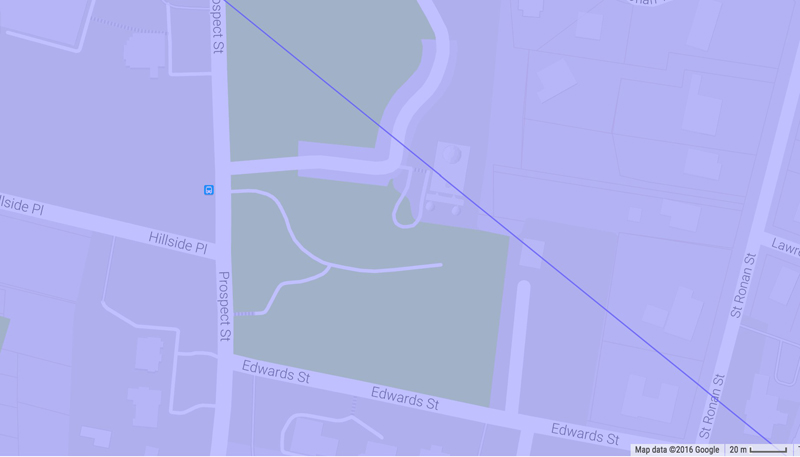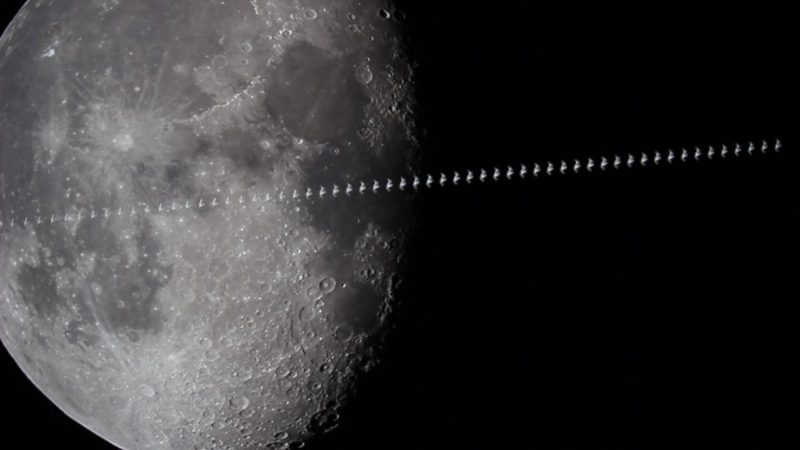ISS Transit (continued):
While the positions and timing of many astronomical events are known to incredible precision, the orbit of the ISS is susceptible to changes due to atmospheric drag and the occasional need to adjust orbital height. Because of this, transit-finder.com cautions that “predictions further than 10-14 days should be treated as a rough approximation – both the timing and the position of the event may change significantly”.
As the date of the transit approached, the predicted path did change, drifting toward the south, to a new location near the Long Warf area of New Haven. The transit visibility path is only about 2 miles wide, so this meant that the LFOP site would now be just outside the viewing zone.
I scoured Google Maps looking for alternative sites to set up my telescope. Setting up as close to the centerline as possible was important for two reasons. The first reason was that even in the final moments leading up to the transit, the predicted center-line accuracy is only within a hundred yards and so I wanted to improve my chances of being in the right spot. Secondly, I really wanted to nail the image of the transit passing directly through the center of the Moon for aesthetic appeal. Any deviation from the center-line of the path would make the ISS transit appear to be offset or worse, miss the Moon altogether. A near miss just wouldn’t do!
Since the timing of the event was to be around 6am and not in the middle of the night, I felt comfortable with the possibility of setting up at Long Warf Park along the water or even at the baseball fields at Memorial Park in East Haven without raising concerns about my seemingly suspicious activity. Just in case, I spoke to local police to get permission and make them aware of my intentions. But then, only days prior to the transit, the predicted path moved back to the north, this time precisely centered over the top of the LFOP building. Sometimes it’s better to be lucky than good.

Centerline of transit path directly over LFOP!
With prior permission from the Director of LFOP, I set up my telescope on the lawn just outside the observatory deck. Setting up in the dark of night is not my favorite activity and it took me longer than I would have liked to get things in position and aligned. I had a rough idea of what camera settings to use but I had wanted to experiment with exposures to improve my chances of capturing good images. I also wanted to collimate the scope since it had been riding around in the back of my wife’s truck for the past 2 weeks. But just as I was attaching the cameras and roughing in the focus, my alarm went off, signaling that the ISS was breaking the horizon and would be intersecting the Moon in just a few minutes.
It’s Showtime!
To capture the event, I used a Canon T4i with a 300mm f/4.5 lens riding piggyback for a wide-angle view and a Canon 60D attached to the prime focus of my C11 with a 0.6 focal reducer. The whole show would last just slightly more than half a second so the attempting to precisely time the moment in a single snapshot would be next to impossible. For this reason I chose to record video at 60 frames per second, greatly improving the odds of catching the ISS in front of the Moon.
I pressed the shutter releases of both cameras and stood back and waited. The ISS, blazingly bright at -0.1 magnitude, was fast approaching its rendezvous with the Moon. Since I wasn’t convinced that my exposure settings were correct, I glanced at the LCD screen of the wide-angle camera, hoping to catch a glimpse of the ISS coming into frame. In the instant it took me to look down at the LCD and then back up to the sky, the whole thing was over and the ISS was speeding off to the east. Hopefully the cameras had been able to catch it because I missed seeing the actual event!

Success! The ISS streaks across the sky and the Moon, captured at 60fps.
